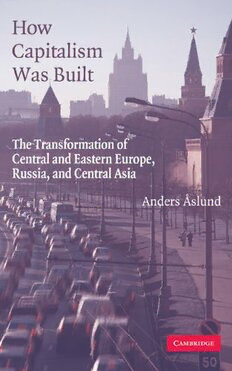Download How Capitalism Was Built: The Transformation of Central and Eastern Europe, Russia, and Central Asia PDF Free - Full Version
Download How Capitalism Was Built: The Transformation of Central and Eastern Europe, Russia, and Central Asia by Anders Aslund in PDF format completely FREE. No registration required, no payment needed. Get instant access to this valuable resource on PDFdrive.to!
About How Capitalism Was Built: The Transformation of Central and Eastern Europe, Russia, and Central Asia
In the 15 or so years after the end of the Cold War, vast economic changes rippled through the Warsaw Pact countries. Aslund chronicles the sometimes unsteady transition from centrally planned economies to market based approaches. Much had to be done. Privatisation was fundamentally different from what happened under that label in the existing capitalist countries. The latter always had strong private sectors. But in the countries surveyed here, privatisation in some cases meant selling off most of a country. Difficult issues of how to "spin off" housing, land and commercial real estate. The rise of the Russian oligarchs gets an entire chapter. Explaining how in the Russian rush to privatise, a few nimble men (and they were all men) managed to acquire vast assets from the state. For the most part, they were able to parlay these into huge conglomerates, and sidestep troublesome questions of fairness. Interesting comparisons are made to the robber barons of the US in the late 19th century. One key difference is that the oligarchs are proved unable to resist Putin's assertion of centralised rule. While in the US, the barons were able to largely hold off Washington for decades.
Detailed Information
| Author: | Anders Aslund |
|---|---|
| Publication Year: | 2007 |
| ISBN: | 9780511342653 |
| Pages: | 374 |
| Language: | English |
| File Size: | 2.767 |
| Format: | |
| Price: | FREE |
Safe & Secure Download - No registration required
Why Choose PDFdrive for Your Free How Capitalism Was Built: The Transformation of Central and Eastern Europe, Russia, and Central Asia Download?
- 100% Free: No hidden fees or subscriptions required for one book every day.
- No Registration: Immediate access is available without creating accounts for one book every day.
- Safe and Secure: Clean downloads without malware or viruses
- Multiple Formats: PDF, MOBI, Mpub,... optimized for all devices
- Educational Resource: Supporting knowledge sharing and learning
Frequently Asked Questions
Is it really free to download How Capitalism Was Built: The Transformation of Central and Eastern Europe, Russia, and Central Asia PDF?
Yes, on https://PDFdrive.to you can download How Capitalism Was Built: The Transformation of Central and Eastern Europe, Russia, and Central Asia by Anders Aslund completely free. We don't require any payment, subscription, or registration to access this PDF file. For 3 books every day.
How can I read How Capitalism Was Built: The Transformation of Central and Eastern Europe, Russia, and Central Asia on my mobile device?
After downloading How Capitalism Was Built: The Transformation of Central and Eastern Europe, Russia, and Central Asia PDF, you can open it with any PDF reader app on your phone or tablet. We recommend using Adobe Acrobat Reader, Apple Books, or Google Play Books for the best reading experience.
Is this the full version of How Capitalism Was Built: The Transformation of Central and Eastern Europe, Russia, and Central Asia?
Yes, this is the complete PDF version of How Capitalism Was Built: The Transformation of Central and Eastern Europe, Russia, and Central Asia by Anders Aslund. You will be able to read the entire content as in the printed version without missing any pages.
Is it legal to download How Capitalism Was Built: The Transformation of Central and Eastern Europe, Russia, and Central Asia PDF for free?
https://PDFdrive.to provides links to free educational resources available online. We do not store any files on our servers. Please be aware of copyright laws in your country before downloading.
The materials shared are intended for research, educational, and personal use in accordance with fair use principles.

